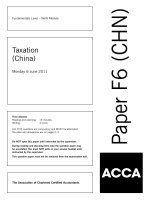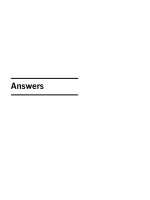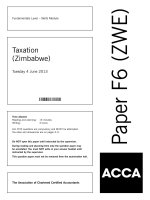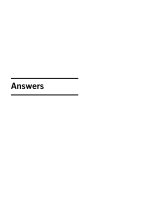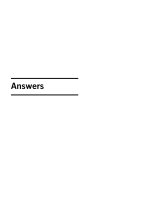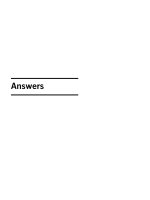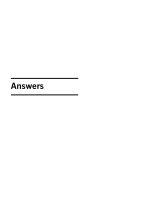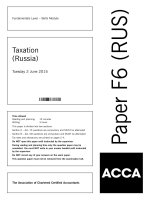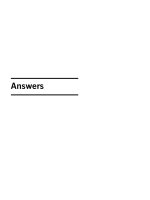ACCA f6 taxation singapore 2011 jun answer
Bạn đang xem bản rút gọn của tài liệu. Xem và tải ngay bản đầy đủ của tài liệu tại đây (127.68 KB, 6 trang )
Answers
Fundamentals Level – Skills Module, Paper F6 (SGP)
Taxation (Singapore)
June 2011 Answers
and Marking Scheme
Marks
1
(a)
Hanafi Pte Ltd
Tax liability for the year of assessment 2011
Basis period: 1 July 2009 to 30 June 2010
$
Net profit as per accounts
Tax adjustments on income
Recovery of trade debt taken over
Interest from OCBC – fixed deposit (separate source)
Interest accrued from DBS (separate source)
One-tier tax exempt dividend (separate source)
Rental (separate source)
Gain on sale of investment
(40,000)
(30,000)
(2,500)
(16,000)
(80,000)
(250,000)
–––––––––
Tax adjustments on expenses
Restructuring costs
Excess CPF Contributions (($6,000 x 12 – $54,000) x 0·145)
Medical expense capping ($5,500 less 1% of {620,000 –
120,000 – 2,610})
Rental of passenger cars
Praying expenses
Cash stolen from cash register
Legal fees – recovery of trade debt
Legal fees – appeal against tax assessment
Interest expense – late payment of trade debt
Interest expense – late payment of CPF
Exchange loss on trading stocks
Non-trade exchange loss
Donations
Depreciation
Less: Capital allowances
Laptops and printers (100% of $12,000)
Productivity and Innovation Credit – laptops and printers
(150% of $12,000) (See marking note below)
Handphones (less than $1,000 each – concessionary one-year claim)
Office furniture ($20,000 x 75%)
Van ($48,000 x 75%)
Trade adjusted profit
Add: Non-trade income
Interest from OCBC
Interest from DBS
Dividends – Singapore (one-tier – exempt)
Rental income (not remitted)
0·5
(418,500)
1·0
0·5
0·5
0·5
0·5
0·5
120,000
2,610
1·0
1·5
526
8,000
850
0
0
12,000
0
1,200
0
20,000
30,000
240,000
–––––––––
2·0
1·0
1·0
1·0
1·0
1·0
1·0
1·0
1·0
1·0
0·5
0·5
435,186
–––––––––
616,686
(12,000)
1·0
(18,000)
(9,000)
(15,000)
(36,000)
–––––––––
1·0
1·0
0·5
0·5
30,000
2,500
0
0
–––––––––
Statutory income
Less: Approved cash donation ($10,000 x 2·5)
Assessable/Chargeable income
Less: Partial tax exemption
First $10,000 – 75% exempt
Next $290,000 – 50% exempt
$
600,000
(7,500)
(145,000)
–––––––––
(90,000)
–––––––––
526,686
32,500
–––––––––
559,186
(25,000)
–––––––––
534,186
0·5
0·5
0·5
1·0
1·0
0·5
Chargeable income after partial exemption
(152,500)
–––––––––
381,686
–––––––––
–––––––––
Tax thereon at 17%
64,887
–––––––––
0·5
–––
27
–––
Marking note:
Enhanced PIC capital allowances computed based on the total of 400% of qualifying expenditure would also have been
accepted as correct, even though the revised rate of 400% was announced after September 2010.
13
Marks
(b)
Resident status would be advantageous in the following circumstances:
1.
Only a new start-up company that is a tax resident company can potentially qualify for full tax
exemption on the first $100,000 of chargeable income for the first three years of assessment after
incorporation under the tax exemption scheme for new start-up companies. Non-tax resident companies
are excluded from the scheme.
2.
Only a tax resident company can qualify for tax exemption on the remittance of certain foreign-sourced
income such as dividends, branch profits and service income.
3.
Only a tax resident company can claim double taxation reliefs.
4.
Only a tax resident company can claim unilateral tax reliefs.
–––
3
–––
30
–––
–––
(Note: One mark to be awarded for each of the above 4 points, maximum 3 marks)
2
(a)
Isabelle Choy
Tax liability for the year of assessment 2011
$
Trade income
Share of partnership loss (restricted to contributed capital)
Employment income
Salary ($13,000 x 12)
Bonus – contractual 2010
No adjustment for 2009 bonus
Bonus – Non-contractual paid January 2010
No adjustment for non-contractual bonus paid January 2011.
Stock options ([$3·00 – $1·30] x 100,000)
Car benefits [(3/7 x 1/10 x $140,000) + (10,000 x $0·55)]
Holiday passage (100% of $2,400)
Birthday gifts
Christmas hamper (not exceeding $200)
Housing benefit – lower of annual value of $72,000 and 10%
of $379,300
(25,000)
156,000
13,000
0
26,000
0
170,000
11,500
2,400
400
0
––––––––
379,300
37,930
––––––––
Interest income
Royalty (10% of $3,000)
Less: donation ($2,000 x 2·5)
Less:
Earned income
Spouse relief (husband’s income > $4,000)
Qualifying child relief
Working mother child relief (capped)
(lower of 15% of $392,230 or $50,000 less $4,000)
CPF (capped at 20% of $76,500)
Wife of NSman
Tax on first $320,000
Tax on balance of $9,280 at 20%
$
0·5
1·0
0·5
1·0
0·5
1·5
2·0
1·0
1·0
1·0
417,230
2·0
8,800
300
––––––––
401,330
(5,000)
––––––––
396,330
1·0
1·0
14
1·0
(1,000)
0
(4,000)
0·5
0·5
0·5
(46,000)
(15,300)
(750)
––––––––
1·0
1·0
0·5
(67,050)
––––––––
329,280
––––––––
––––––––
42,700
1,856
––––––––
44,556
––––––––
Tax payable
1·5
0·5
–––
21
–––
Marks
(b)
A married couple are allowed to transfer any excess qualifying deductions arising from unabsorbed tax losses,
capital allowances and donations to his/her spouse for utilisation against the spouses taxable income.
In cases where both spouses have rental income, one spouse is allowed to transfer a rental deficit to set off
against positive taxable rental of the other spouse. However, no amount of the rental deficit can be set off
against any other income of their spouse.
3
(a)
Under the Goods and Services Tax Act, every person who makes an annual turnover of taxable supplies (i.e.
standard and/or zero-rated supplies) of goods and services exceeding or expected to exceed $1 million in
value is required to register for goods and services tax (GST).
2
2
–––
4
–––
25
–––
–––
1
In determining whether this threshold is met, two bases are used:
Retrospective basis
Under the retrospective basis, registration is compulsory if at the end of any quarter, the total value of the
taxable supplies made in Singapore in that quarter plus the previous three quarters has exceeded $1 million.
The Comptroller must be notified within 30 days of the end of the quarter.
0·5
Prospective basis
Under the prospective basis, registration is compulsory if at any time, there are reasonable grounds to believe
that the total value of taxable supplies to be made in the next 12 months will exceed $1 million.
The Comptroller must be notified within 30 days of the beginning of the period.
(b)
1
0·5
–––
4
–––
A person not liable to register for GST must satisfy the Comptroller that he either:
–
–
makes taxable supplies; or
intends to make such supplies in the course or furtherance of his business.
1·5
Once registered the trader will have to charge GST on his sales but will also be able to reclaim input taxes
on his purchases.
(c)
1
1·5
–––
3
–––
Hector Manufacturing Pte Ltd
Goods and services tax (GST) for the quarter ended 31 March 2010
Value
$
Local sales
500,000
Export sales (zero-rated)
100,000
Re-billing of rental expense to related company
5,000
Imports of trading stock
200,000
Purchases of equipment
50,000
Salaries and CPF (out-of-scope)
80,000
Rental of office premises
45,000
Rental of apartment for staff (exempt)
30,000
Repair costs of lorries and vans
3,000
Monthly subscription fees to golf club (taxable but blocked) 2,000
Net GST payable
15
Input tax
$
14,000
3,500
0
3,150
0
210
0
–––––––
20,860
Output tax
$
35,000
0
350
–––––––
35,350
(20,860)
–––––––
14,490
–––––––
0·5
1·0
1·0
0·5
0·5
1·0
0·5
1·0
0·5
1·0
0·5
–––
8
–––
15
–––
–––
Marks
4
Systematic Solutions Pte Ltd (SSPL)
(a)
(i)
The fee of $400,000 paid by SSPL is for the right to use the technology and information developed by
Overseas Corporate Consultancy Ltd (OCCL) in the course materials used. It relates to a royalty payment
on the premise that such information is proprietary to OCCL.
1
The income is deemed to be sourced in Singapore [under s.12(7)(a) or (b)(i)] as it is borne directly or
indirectly by SSPL, a person resident in Singapore and the payment is an expense deductible against
the Singapore-sourced income of SSPL.
2
The gross payment is subject to a final withholding tax of 10%. This is provided OCCL does not derive
the income from any trade or business carried on in Singapore and the royalty income is not effectively
connected to any permanent establishment of OCCL in Singapore; if this is not the case, then the tax
withheld will be at the prevailing corporate tax rate, currently 17%.
2
The withholding tax has to be accounted for to the Inland Revenue Authority of Singapore (IRAS) by the
15th day of the month following the date of payment. Failure to comply with this time limit will result
in late payment penalties of up to 20% of the withholding tax payable.
(ii)
(b)
If a fee of $50,000 is paid by SSPL for the outright sale of the course materials, the deemed source
provisions would not apply and the payment would not be construed as a royalty payment. Accordingly,
no tax would need to be withheld by SSPL.
(a)
2
–––
The payment of $200,000 for the consultancy services relating to the curriculum planning would be
construed as technical or ‘show-how’ services [under s.12(7)(b)(ii)]. Such services are more akin to those
of a professional or technical nature, not a royalty.
2
The payment will be subject to a non-final withholding tax of 17% on the gross amount paid. Again this
would be paid to the IRAS by the 15th day of the month following the date of payment and failure to do so
will result in late payment penalties of up to 20% of the withholding tax payable.
2
By concession, no withholding tax will be applicable if the services are provided entirely outside Singapore.
However, as in this case there is no separate value attached to the portion of services that will be rendered
outside Singapore, the full amount of fee payable will be subject to Singapore withholding tax.
5
2
–––
7
–––
2
–––
6
–––
15
–––
–––
Errand Pte Ltd (EPL)
For filing an incorrect tax return, even in the case of a genuine or honest mistake, EPL may be liable upon
conviction to a penalty of 100% of the tax undercharged.
1
Where negligence is involved or where EPL has no reasonable excuse for filing an incorrect tax return or
information, the penalty will be based on 200% of the tax undercharged.
1
If the omission or over claim is due to fraud or evasion of tax, the penalty will be based on 300% of the tax
undercharged.
1
Where serious fraudulent tax evasion is involved the penalty will be based on 400% of the tax undercharged.
16
1
–––
4
–––
Marks
(b)
Michael and Felicia
Assessable income for the year of assessment 2011
$
Net profit as per partnership accounts
Add
Partner’s salary
Depreciation
Donations
50,000
24,000
8,000
–––––––
Less
Deduction for qualifying renovation and refurbishment expenses [s.14Q]
– One year ($2,400 + $3,200 + $1,200 + $3,200)
Divisible profit
Less: Capital allowances
Less: Share of unabsorbed capital allowances bought forward
Less: Share of unabsorbed tax losses brought forward
Unabsorbed tax losses carried forward
Unabsorbed donations carried forward (2·5 x 4,000)
Assessable income
17
82,000
––––––––
322,000
(10,000)
––––––––
312,000
(50,000)
––––––––
262,000
––––––––
––––––––
Less: Partner’s salary
Salary
Divisible profit
$
240,000
Michael
$
50,000
157,200
––––––––
207,200
(1,800)
––––––––
205,400
––––––––
(30,000)
(180,000)
––––––––
(4,600)
––––––––
––––––––
(6,000)
––––––––
0
––––––––
––––––––
0·5
0·5
0·5
0·5
2·0
0·5
Felicia
$
–
104,800
––––––––
104,800
(1,200)
––––––––
103,600
––––––––
(20,000)
(120,000)
––––––––
(36,400)
––––––––
––––––––
(4,000)
––––––––
0
––––––––
––––––––
0·5
1·0
1·0
1·0
1·0
0·5
1·0
0·5
–––
11
–––
15
–––
–––
